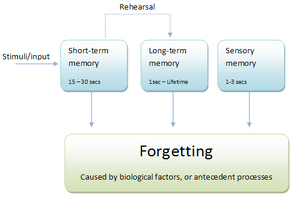Assessment |
Biopsychology |
Comparative |
Cognitive |
Developmental |
Language |
Individual differences |
Personality |
Philosophy |
Social |
Methods |
Statistics |
Clinical |
Educational |
Industrial |
Professional items |
World psychology |
Cognitive Psychology: Attention · Decision making · Learning · Judgement · Memory · Motivation · Perception · Reasoning · Thinking - Cognitive processes Cognition - Outline Index

A corrected visual representation of the Atkinson-Shiffrin model. Note that in this diagram, sensory memory is detached from either form of memory, and represents its devolvement from short term and long term memory, due to its storage being used primarily on a "run time" basis for physical or psychosomatic reference.
The Atkinson-Shiffrin model, Multi-store model or Multi-memory model is a psychological model proposed in 1968 as a proposal for the structure of memory. It proposed that human memory involves a sequence of three stages:
- Sensory memory (SM)
- Working memory or short-term memory (STM)
- Long-term memory (LTM)
Evidence
In a type of memory test called a free recall task, subjects memorize a list of words and then repeat them. When they are allowed to repeat the words immediately after memorizing them, subjects recall the last few words in the list much better than words in the middle. But if subjects are delayed before they are given a chance to repeat the words, this effect disappears. This effect is called the recency effect. Atkinson and Shiffrin used this as evidence that the words at the end were still being held in the sensory memory.
In another version of the free recall task, subjects were given a list of words that sounded similar (like cat, map, man, mat). On these tests, subjects performed very poorly. When they were given lists of words that sounded unrelated, but had similar meanings, their immediate recall was normal. But when asked to recall the similar words after a delay, suddenly they performed much better than they did after delays when the words were unrelated. Atkinson and Shiffrin believed this to show that short term memory uses acoustic information, but long term memory encodes things based on their meaning.
Amnesics with impaired long-term memory systems have been given similar tasks. They tend to perform just as well as healthy control subjects, which led Atkinson and Shiffrin to believe this was still more evidence for separate short-term and long-term memory systems.
\
See also
References & Bibliography
Key texts
Books
Papers
Atkinson, R.C. & Shiffrin, R.M. (1968) Human memory: A proposed system and its control processes. In K.W. Spence and J.T. Spence (Eds.), The psychology of learning and motivation, vol. 8. London: Academic Press.
Additional material
Books
Papers
External links
- Science aid: Multi Store Model Easy to understand yet comprehensive article on the model
- Simply Psychology webpage on multistore model